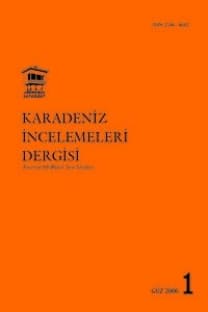TRABZON MÜZESİNDE BULUNAN OSMANLI DÖNEMİNE AİT BİR TAŞ BASKI
Geç Osmanlı Dönemi, Litografi Taşı, Trabzon Müzesi, Osmanlı ticari yaşamı, Çanakkale Boğazı Haritası
AN OTTOMAN LITHOGRAPHIC STONE FROM THE TRABZON MUSEUM
Late Ottoman Period, Lithography Stone, Trabzon Museum, Ottoman Commercial life, Map of the Çanakkale Strait,
___
- ALBAYRAK, Hüseyin, Trabzon Basın Tarihi, Türk Diyanet Vakfı, Ankara 1994.
- ALBAYRAK, Hüseyin, “Doğu Karadeniz Bölgesinde ilk Matbaa, İlk Gazete ve İlk Salname”, Karadeniz Araştırmaları, No: 4, Year: 2005, pp. 39-52.
- ATAR, Atilla, Başlangıcından Günümüze Taşbaskı, Anadolu Üniversitesi Yayınları, Eskişehir 1995.
- BİRİNCİ, Ali, “Trabzon’da Matbuat ve Neşriyyât Hayatı, 1865-1928”, Trabzon 88-89 Kültür Sanat Yıllığı, Çetin Ofset, İstanbul 1989, pp. 173-188.
- BAŞKAYA, Muzaffer, Cumhuriyetin İlk Yıllarında Trabzon’da Ekonomik Hayat (1923-1950). Serander Yayınevi, Trabzon 2015.
- COŞAR, Ömer Sami, Milli Mücadele Basını, Gazeteciler Cemiyeti Yayınları, İstanbul 1964.
- ÇAPA, Mesut and Rahmi ÇİÇEK, Yirminci Yüzyıl Başlarında Trabzon’da Yaşam, Serander Yayınevi, Trabzon 2004.
- FRITZ, Georg, Handbuch der Lithographie: nach dem gegenwärtigen Stande dieser Technik, W. Knapp, Halle 1901.
- GERÇEK, Selim Nüzhet, Türk Taş Basmacılığı, Maarif Vekâleti, İstanbul 1939.
- KESKİN, İsmail, “1831-1920 yılları arası Türkiye’deki Litografi (taşbaskı) Sanatı”, Atatürk Üniversitesi Güzel Sanatlar Enstitüsü Dergisi, No: 38, Year: 2017, pp. 9-20.
- KÜÇÜKERMAN, Önder Osmanlı’dan Cumhuriyet’e Bir Yayıncı: Kitabi Hamdi Efendi ve Trabzon, Boyut Yayıncılık, İstanbul 2014.
- ÖZEL, Sabahattin, Milli Mücadele’de Trabzon, İş Bankası Yayınları, İstanbul 2012.
- PIETSCH, Ludwig, Alois Senefelder, Erfinder der Lithographie. Festschrift zum 100sten Geburstage Senefelder's am 6. November 1871, Springer'sche Buchhandlung Berlin. 1873.
- POPPE, J. H. M. Die Lithographie oder Steindruckerei im ganzen Umfang und in allen Manieren nach den neuesten Erfindungen, Stuttgart 1833.
- PROTHERO, George, Armenia and Kurdistan, H.M. Stationery Office, London 1920.
- RAYNDAL, G. Bie, “Turkey”, United States Department of Commerce. Supplement to Commerce Reports Trade and Economic Review for 1922, No: 35, (Published by the Bureau of Foreign and Domestic Commerce), 1924, pp. 1-28.
- SENEFELDER, Alois. Vollständiges Lehrbuch der Steindruckerei, München 1818.
- STRAUSS, J. “Livre français d’Istanbul (1730-1908)”, Livres et lecture dans le monde ottoman. Revue des mondes musulmans et de la Méditerranée. Paris 1999, pp. 277-301.
- YAŞAYANLAR, İsmail, “Yirminci Yüzyılda Trabzon’da Sağlık Hizmetleri: Hastaneler, Hekimler, Eczacılar.” Journal of Turkish Studies, No: 52, Year: 2019, pp. 355-372.
- WEBER, Wilhelm, Aloys Senefelder, Erfinder der Lithographie: Daten zum Leben und Wirken, Polygraph Verlag, Frankfurt 1981.
- ZELLICH, Grégoire, Notice historique sur la lithographie et sur les origines de son introduction en Turquie, Istanbul 1895.
- ZELLICH, Grégoire, “Türkiye’de taş basmacılığı”, (Trans. by O. Yüksel) Hayat Tarih Mecmuası, No: 5, Year: 1973, pp. 24-27.
- ZELLICH, Grégoire, “Türkiye’deki litografi taşı yatakları”, (Trans. by O. Yüksel) Hayat Tarih Mecmuası, No: 6, Year: 1973, pp. 66-68.
- ISSN: 2146-4642
- Yayın Aralığı: 2
- Başlangıç: 2006
- Yayıncı: Karadeniz İncelemeleri Dergisi
RİZE AĞZINDA ed-e KULLANIMI VE -n-,-t- EKLERİNİN PEKİŞTİRME FONKSİYONU ÜZERİNE
KAFKASYA’DA RUS KÜLTÜR POLİTİKALARI (XIX.-XX. YÜZYIL)
TRABZON’DA YORGANCILIK SANATI, USTALAR VE ESERLERİ
BÜROKRASİDEN SİYASETE TÜRKİYE BÜYÜK MİLLET MECLİSİNİN XIV. BAŞKANI NECMETTİN KARADUMAN
1834 YILINDA BİR OSMANLI VALİSİNİN KAPI HALKI: TRABZON VALİSİ HAZİNEDARZÂDE OSMAN PAŞA’NIN MAİYETİ
ALTIN ORDA HANLIĞI’NDA “SARAY”IN BÜYÜK HATUNU: TAYTUĞLI HATUN
TRABZON ÇEPNİ AĞZINDAN SEÇİLMİŞ METİNLER ÜZERİNDE BAĞDAŞIKLIK ÖLÇÜTLERİ İNCELEMESİ
SAMSUN’DA OSMANLI DÖNEMİ ÂSÂR-I ATÎKA ARAŞTIRMALARI (1863-1911)
